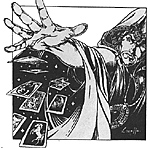
[Warning: This strategy piece contains one piece of deliberate disinformation. -GS]
In On The Edge, you're a ruthless conspirator with a subtle and wide-reaching grasp, working behind the scenes to achieve some unguessable goal. Unfortunately, you're not the only devious plotter in town.
Characters are the key to victory. With a very few exceptions, characters have pull that turns into influence, and influence is what wins the game. The player who wins is the player who can get the most pull-bearing characters into play and protect them while they pump up the influence. This is easier said than done, however. Since you lose influence when a pull-bearing character dies, you also need to protect your characters - and it doesn't hurt to be able to wipe out your enemies as well.
Basically then, we have three kinds of cards; pull cards (resources and characters with pull), stabbers (bloodstained meatheads, good for killing things) and blockers (characters who don't mind taking a knife in the gut for The Boss). Each of these will be dealt with in turn.
The first, and most important, are the pull cards. Resources are necessary because they cost nothing to put down and can bring in other cards. If you don't get a Resource out on your first turn, you're way behind from the start.
One way to crash and burn is to have a hand full of high powered, high pull, high cost cards - and not have the resources to access them. On the other hand, you can also croak out by having a table full of unused Resource cards.
The best ratio I've found is; one fifth of your deck should be Resource cards. Your deck will work much better if you have "themes" to it. Since cards often work together, a Glug/Compton/Entrepreneur deck is probably going to be a better deck than one that was assembled by just grabbing characters with high scores and funky powers.
The more important kind of pull card is the pull character, because they can bring influence for victory. You want your deck to be heavy on them - another fifth or more. Don't be dazzled by high-cost, high-pull heavies - it's the one point wonders that are the backbone of your conspiracy. Getting out a one cost, one pull character on your first turn means you can crank him or her to get out another one cost, one pull character, and so on and so forth. like a string of firecrackers, each sets off the next; voila! Instant intrigue! The most common one point/one pull characters tend to Entrepreneurs and Artists.
The next level to your conspiracy is the all-pain-no-gain, all-guts-no-brain, "you want I should put him in the car compactor now?" types; I call them stabbers. This can be a high attack type, a character who's been loaded down with gear (gear are cards that make a character tougher), or a character with sneaky abilities that enable them to attack effectively. Compton cards and Astral cards tend to be good stabbers.
Blockers are there to counteract an opponent's stabber. These are characters with high defense scores. Being immune to different effects doesn't hurt either. Don't crank these guys; otherwise they can be bypassed. Keep them in front of your pull cards and try not to let them be controlled. Glugs make excellent blockers because they're immune to just about everything.
Gear, conditions and whammies are nice, but not fundamental; in a 40 card deck, I find that 5 of these cards are enough. Gear is mostly good for altering combat in the long term, so it should go on stabbers and blockers. Some whammies and conditions can avoid the effects of combat altogether, but often work one time only.
Finally, many of the best conditions and gears can only be called if you have certain types of cards in play; you can only put Terrors on someone if you have Astral or Compton cards, and you can only get Seklut Poison if you have Glorious Lords. If you've picked themc, for your deck, it will make choosing your gcoi much easier.
When you actually get into play, use the firecracker effect; cranking a one cost/one pull card to summon another, etc. Just remember that these firecracker strings should end with actual blockers for each rank.
As soon as you can, start putting pressure on your opponent. Cripple pull to prevent your opponent from being effective. If you've got a Sabotage (which wipes out a resource) in your hand early in the game, play it as soon as possible; if you hold it back waiting for a rare resource like "The Throckmorton Device" or "Red Orca," your opponent will be able to crank "Al Amarjan Friends" six or eight times.
In multiple opponent play, it's best to pace yourself and play conservatively; any player who throws out four pullers and starts racking up influence early is going to become the designated whipping boy. If you scare them, they'll gang up on you. It's much better to play a "Why don't you and him fight?" game.
Good luck, conspirator, and remember; if any of these strategies backfire, it's a learning experience to teach you the value of disinformation.
More Up My Sleeve edited by David Williams
- The World of Card Games by David Williams.
Single Card Strategies: This Month's Card: Lure by Jeff Scott Franzman.
Strategy for Powermad Control Freaks: Tips for Trident's On the Edge by Greg Stolze.
Back to Shadis #17 Table of Contents
Back to Shadis List of Issues
Back to MagWeb Master List of Magazines
© Copyright 1995 by Alderac Entertainment Group
This article appears in MagWeb (Magazine Web) on the Internet World Wide Web.
Other military history articles and gaming articles are available at http://www.magweb.com